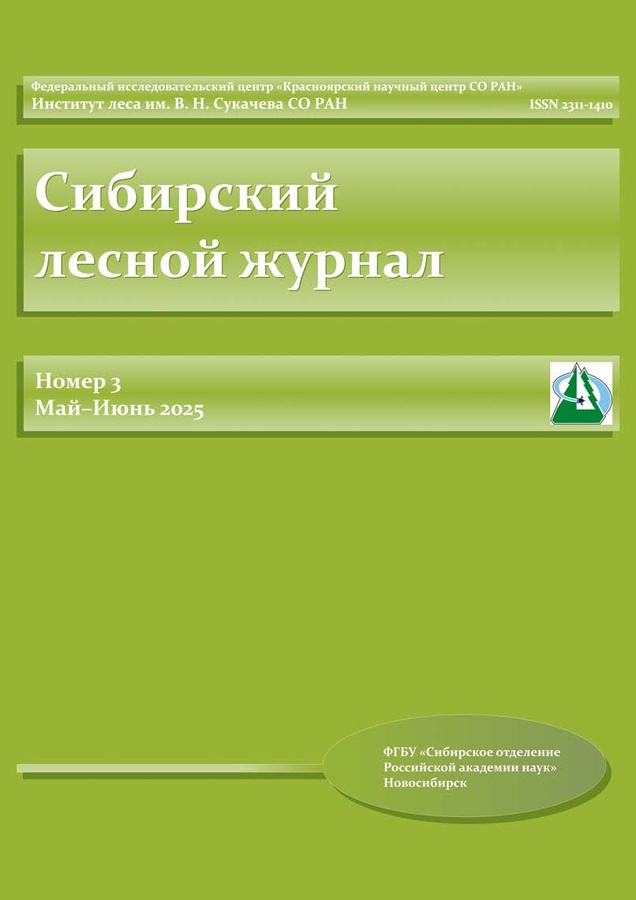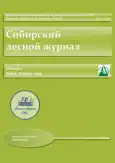ОПРЕДЕЛЕНИЕ УЩЕРБА ЛЕСНЫМ ЭКОСИСТЕМАМ ПРИ ПОРАЖЕНИИ СИБИРСКИМ ШЕЛКОПРЯДОМ
- Авторы: Фарбер С.К.1, Солдатов В.В.2, Кузьмик Н.С.1, Петров В.Н.3, Корякин В.А.4
-
Учреждения:
- Красноярский научный центр СО РАН, Институт леса им. В. Н. Сукачева СО РАН
- Центр защиты леса Красноярского края, Филиал Российского центра защиты леса
- Санкт-Петербургский государственный лесотехнический университет имени С.М. Кирова
- Всероссийский научно-исследовательский институт лесоводства и механизации лесного хозяйства
- Выпуск: № 2 (2024)
- Страницы: 21-33
- Раздел: ИССЛЕДОВАТЕЛЬСКИЕ СТАТЬИ
- URL: https://journal-vniispk.ru/2311-1410/article/view/297602
- DOI: https://doi.org/10.15372/SJFS20240203
- ID: 297602
Цитировать
Полный текст
Аннотация
Рассмотрены вопросы последовательности расчета ущерба южно-таежным лесам Енисейского, Нижне-Енисейского, Северо-Енисейского лесничеств Красноярского края после вспышки массового размножения сибирского шелкопряда ( Dendrolimus sibiricus Tschetverikov) в 2016-2018 гг. Площадь с различной степенью поражения насаждений составила 803 983 га при общей площади лесотаксационных выделов, на которых зафиксирована гибель древостоя, 2 034 665 га. Принимается положение, что размер ущерба равен разности стоимости насаждения до и после внешнего воздействия. Задача определения ущерба сводится к выявлению стоимости насаждения. Показано, что стоимость можно представить как сумму экосистемных (экологических и ресурсных) функций насаждения. Расчет выполняется относительно определенной функции, стоимость которой известна. В качестве такой функции использован древесный ресурс, который в виде таксовой ставки платы сбалансирован по местоположению, породам деревьев, классам товарности, и широко используется в качестве нормативного показателя при установлении платы за лесопользование. Для расчета ущерба в качестве исходных данных использовались материалы массовой таксации. Описания лесотаксационных выделов анализировались отдельно для защитных, эксплуатационных и резервных лесов. Расчеты проведены по преобладающим породам деревьев. Стоимость защитных лесов получилась больше, чем эксплуатационных, а стоимость экосистемных функций насаждений оказалась на порядок выше таксовой стоимости древесного ресурса. Общая стоимость насаждений до вспышки массового размножения сибирского шелкопряда определена в размере 70 275.2 млн руб., после вспышки - 52 249.8 млн руб. Общий ущерб лесам составил 8 025.5 млн руб. - 25.7 % от стоимости насаждений до вспышки массового размножения сибирского шелкопряда.
Об авторах
С. К. Фарбер
Красноярский научный центр СО РАН, Институт леса им. В. Н. Сукачева СО РАН
Автор, ответственный за переписку.
Email: sfarber@ksc.krasn.ru
Красноярск, Россия
В. В. Солдатов
Центр защиты леса Красноярского края, Филиал Российского центра защиты леса
Email: soldatovvv@rcfh.ru
Красноярск, Россия
Н. С. Кузьмик
Красноярский научный центр СО РАН, Институт леса им. В. Н. Сукачева СО РАН
Email: kuzmik@ksc.krasn.ru
Красноярск, Россия
Владимир Николаевич Петров
Санкт-Петербургский государственный лесотехнический университет имени С.М. Кирова
Email: wladimirpetrov@mail.ru
Василий Анатольевич Корякин
Всероссийский научно-исследовательский институт лесоводства и механизации лесного хозяйства
Email: koryakin_va@mail.ru
Список литературы
- Анучин Н. П. Сортиментные и товарные таблицы. 7-е изд., перераб. и доп. М.: Лесн. пром-сть, 1981. 536 с
- Баранчиков Ю. Н., Кондаков Ю. П., Петренко Е. С. Катастрофические вспышки массового размножения шелкопряда в лесах Красноярского края // Безопасность России. Региональные проблемы безопасности. Красноярский край. М.: МГФ «Знание», 2001. С. 146-167
- Бобылев С. Н. Краткая характеристика современной практики управления данной группой экосистемных услуг в России // Экосистемные услуги наземных экосистем России: первые шаги. Status Quo Report. М.: Центр охраны дикой природы, 2013. С. 39-42
- Бобылев С. Н., Медведева О. Е., Соловьева С. В. Экономика сохранения биоразнообразия. М.: Проект ГЭФ «Сохранение биоразнообразия Российской Федерации», Ин-т экон. природопольз., 2002. 604 с
- Гниненко Ю. И. Вспышки массового размножения лесных насекомых в лесах Сибири и на Дальнем Востоке в последней четверти ХХ века // Лесохоз. информ. 2003. № 1. С. 46-57
- Горохов В. А. Городское зеленое строительство: Учеб. пособие для вузов. М.: Стройиздат, 1991. 416 с
- Денисов Б. С. Современные проблемы защиты леса // Лесохоз. информ. 2003. № 2. С. 23-25
- Касимов Д. В., Касимов В. Д. Некоторые подходы к оценке экосистемных функций (услуг) лесных насаждений в практике природопользования. М.: Мир науки, 2015. 91 с
- Матвеев А. М., Матвеева Т. А. Задержание осадков кронами древесных пород // Усп. cовр. естествозн. 2014. № 5-1. С. 220-223
- Молчанов А. А. Лес и окружающая среда. М.: Наука, 1968. 246 с
- Молчанов А. А. Влияние леса на окружающую среду. М.: Наука, 1973. 357 с
- Петров В. Н., Каткова Т. Е., Карвинен С. Сравнительный анализ экономических показателей лесного хозяйства России и Финляндии // Экон. журн. ВШЭ. 2018. Т. 22. № 2. С. 294-319
- Постановление Правительства РФ от 22.05.2007 № 310 «О ставках платы за единицу объема лесных ресурсов и ставках платы за единицу площади лесного участка, находящегося в федеральной собственности». М.: Правительство РФ, 2007
- Постановление Правительства Красноярского края от 07.04.2009 № 178-п «Об утверждении кадастровой стоимости 1 гектара лесных земель лесного фонда на территории Красноярского края». Красноярск: Правительство Красноярского края, 2009
- Прешкин Г. А. Затратный подход к оценке лесных благ // Лесн. вестн. 2010. № 5. С. 203-208
- Приказ Федеральной службы лесного хозяйства России от 10.03.2000 № 43 «Об утверждении Методики экономической оценки лесов». М.: Фед. служба лесн. хоз-ва России, 2000
- Приказ Федеральной службы земельного кадастра России «Об утверждении Методики государственной кадастровой оценки земель лесного фонда Российской Федерации» от 17.10.2002 № П/336. М.: Росземкадастр, 2002
- Рожков А. С. Вспышки массового размножения сибирского шелкопряда. М.: Изд-во АН СССР, 1965. 165 с
- Тупыця Ю. Ю. Экономические проблемы комплексного использования и охраны лесных ресурсов (Вопросы теории). Киев: Вища школа, 1976. 215 с
- Фарбер С. К., Злобин Д. В., Кузьмик Н. С. Оценка экологических функций городских посадок // Интерэкспо Гео-Сибирь. 2021. Т. 4. № 2. С. 166-170
- Хорошев А. В. Анализ имеющихся данных для подготовки прототипа // Экосистемные услуги наземных экосистем России: первые шаги. Status Quo Report. М.: Центр охраны дикой природы, 2013. C. 26-38
- Balmford A., Bruner A., Cooper P., Costanza R., Farber S., Green R. E., Jenkins M., Jefferiss P., Jessamy V., Madden J., Munro K., Myers N., Naeem S., Paavola J., Rayment M., Rosendo S., Roughgarden J., Trumper K., Turner R. K. Economic reasons for conserving wild nature // Science. 2002. V. 297. N. 5583. P. 950-953
- Costanza R., d’Arge R., de Groot R., Farber S., Grasso M., Hannon B., Limburg K., Naeem S., O’Neill R. V., Paruelo J., Raskin R. G., Sutton P., van den Belt M. The value of the wоrld’s ecosystem services and natural capital // Nature. 1997. V. 387. Iss. 15. P. 253-260
Дополнительные файлы











